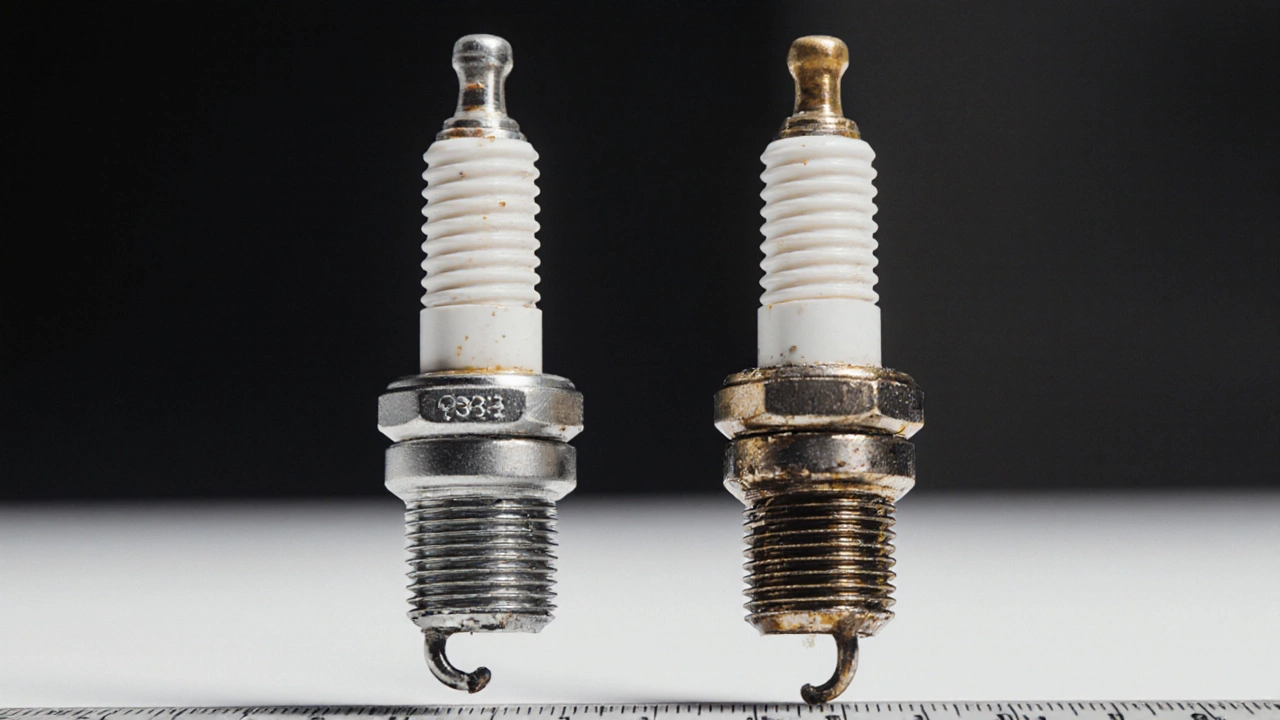 Oct, 30 2025
Oct, 30 2025
Spark Plug Health Checker
Check Your Spark Plug Condition
This tool helps determine if your spark plugs need replacing based on common symptoms. Check all symptoms you're experiencing:
Result Summary
If your car sputters on cold mornings, hesitates when you press the gas, or suddenly loses power on the highway, it’s not just bad luck. More than likely, your spark plugs are worn out. Spark plugs are small, but they do the heavy lifting-igniting the fuel-air mixture in your engine cylinders over 1,000 times per minute. When they fail, your engine doesn’t just run poorly. It can damage other parts, waste fuel, and even leave you stranded.
Sign #1: Engine Misfires
One of the clearest signs your spark plugs are failing is an engine misfire. You’ll feel it as a rough idle or a sudden jerk when accelerating. Sometimes, it sounds like the engine is coughing or popping. Modern cars will trigger a check engine light and store a diagnostic code-often P0300 (random misfire) or P0301 through P0308 (cylinder-specific misfire). But you don’t need a scanner to know something’s wrong. If your car feels like it’s stumbling when you’re driving at a steady speed, especially uphill, the spark plugs are probably the culprit.
Sign #2: Poor Fuel Economy
Bad spark plugs don’t ignite fuel cleanly. That means unburned fuel escapes through the exhaust instead of pushing the pistons down. In Hamilton winters, where short trips and frequent idling are common, this inefficiency adds up fast. If you’ve noticed your tank doesn’t last as long as it used to-even with no changes in driving habits-you’re likely burning 5% to 15% more fuel than you should. A 2023 study by the U.S. Department of Energy found that worn spark plugs can reduce fuel efficiency by up to 30% in older vehicles. That’s over $200 a year extra on gas for the average driver.
Sign #3: Slow or Hard Starting
Ever turn the key and hear the engine crank for three seconds before it finally catches? That’s not normal. Healthy spark plugs ignite fuel instantly, even in freezing temperatures. If your car struggles to start-especially after sitting overnight-it’s a sign the spark has weakened. This isn’t always the battery. If your battery tested fine and your starter turns over strong, the spark plugs are the next thing to check. I’ve seen cars in Hamilton that wouldn’t start in -20°C until the spark plugs were replaced. Afterward, they fired up like new.
Sign #4: Rough Idle
When you’re stopped at a light and the engine shakes like it’s about to die, that’s a rough idle. It’s caused by uneven combustion. One or more cylinders aren’t firing properly because the spark plug isn’t delivering a strong enough spark. You might even notice the RPM needle bouncing. A healthy engine idles smooth and steady, like a metronome. If yours feels like it’s shuddering, it’s not just annoying-it’s a sign of misfires that can damage your catalytic converter over time.

Sign #5: Loss of Power or Acceleration
Remember when your car felt like it could zip past traffic with ease? Now, it feels sluggish. That’s not just old age. Worn spark plugs lose their ability to create a strong, consistent spark. The result? Less power in every cylinder. You’ll notice it most when merging onto the highway or climbing a hill. The engine will feel like it’s running on three cylinders instead of four or six. This isn’t just inconvenient-it’s dangerous. If you can’t accelerate quickly when needed, you’re putting yourself and others at risk.
Sign #6: Check Engine Light
Yes, the check engine light can mean a thousand things. But if it’s flashing, that’s urgent. A flashing light often means a severe misfire, which can overload your catalytic converter and cause expensive damage. Even a steady light could point to spark plug issues. The most common codes linked to bad plugs are P0300 (random misfire), P0301-P0308 (cylinder misfire), and sometimes P0171 or P0174 (lean fuel mixture). Don’t ignore it. Many auto shops offer free code reads, and that’s the fastest way to narrow down the problem.
Sign #7: Visible Wear or Damage During Inspection
Nothing beats seeing the problem for yourself. If you’re comfortable popping the hood and removing a spark plug, you’ll know right away. A healthy plug has a light tan or grayish color on the electrode. If the electrode is black and sooty, it’s running too rich. If it’s white or blistered, it’s overheating. If the gap is wider than the manufacturer’s spec (usually 0.028 to 0.060 inches), the spark is weak. If the ceramic insulator is cracked, or the metal shell is corroded, it’s time to replace them. I’ve pulled out plugs that looked like they’d been through a war-burned, melted, or coated in oil. Those aren’t just worn. They’re done.
When Should You Replace Spark Plugs?
Most manufacturers recommend replacing spark plugs every 30,000 to 100,000 miles, depending on the type. Copper plugs last 20,000-30,000 miles. Platinum ones go 60,000-100,000. Iridium plugs can last up to 120,000 miles. But those are just guidelines. Real-world conditions matter. In places like Hamilton, where you’re dealing with short trips, salt on the roads, and extreme cold, spark plugs wear faster. If your car is older than 8 years and you’ve never changed the plugs, it’s time-even if the mileage seems low. Age degrades the materials, even if the car hasn’t been driven hard.

What Happens If You Don’t Replace Them?
Ignoring bad spark plugs doesn’t just hurt performance. It can wreck your engine. Unburned fuel floods the catalytic converter, which can overheat and melt internally. Replacing a catalytic converter costs $1,500 or more. Misfires can also damage your oxygen sensors and even the engine’s valves over time. In extreme cases, fuel can wash away the oil film on cylinder walls, leading to piston ring wear. That’s engine-rebuilding territory. Fixing spark plugs costs $100-$300. Fixing the damage they cause? Easily $2,000+
What to Look for When Buying New Spark Plugs
Not all spark plugs are the same. The wrong type can cause more problems. Always match the exact part number for your car. Use your owner’s manual or an online parts lookup tool. Stick to reputable brands: NGK, Denso, Bosch, Champion. Avoid cheap no-name brands-they often have poor electrode quality and inconsistent gaps. Iridium plugs are worth the extra cost if your car came with them. They last longer and provide better fuel efficiency. Don’t upgrade to a hotter or colder plug unless your mechanic recommends it. Wrong heat range can cause pre-ignition or fouling.
How to Check Your Spark Plugs (Quick DIY Guide)
- Turn off the engine and let it cool.
- Remove the ignition coil or boot from one spark plug.
- Use a spark plug socket and ratchet to unscrew the plug.
- Inspect the electrode: color, gap, wear, cracks.
- Compare to a healthy plug (light tan/gray).
- Use a gap tool to measure the gap against your car’s spec.
- Reinstall or replace. Repeat for each plug.
If you’re unsure, take one to a parts store. Most will compare it to a new one for free. If you see heavy carbon buildup, melted electrodes, or a gap wider than 0.080 inches, replace them all.
Final Tip: Don’t Wait for Failure
Spark plugs don’t usually fail suddenly. They degrade slowly. That’s why symptoms creep up. By the time your car feels sluggish or the check engine light comes on, you’re already risking bigger damage. If your car is over 60,000 miles and you don’t know when the plugs were last changed, assume they’re overdue. It’s a cheap fix with big returns-better fuel economy, smoother starts, and fewer surprises on the road.
How often should spark plugs be replaced?
Most spark plugs last between 30,000 and 100,000 miles, depending on the type. Copper plugs need replacing every 20,000-30,000 miles. Platinum plugs last 60,000-100,000 miles. Iridium plugs can go up to 120,000 miles. But if you drive mostly short trips, in cold weather, or with a lot of idling, replace them sooner-every 50,000 miles is a safe rule of thumb.
Can bad spark plugs cause the check engine light to come on?
Yes. Bad spark plugs often trigger misfire codes like P0300 (random misfire) or P0301-P0308 (cylinder-specific misfire). A flashing check engine light means a severe misfire that can damage your catalytic converter. Even a steady light can be caused by weak spark plugs, especially if combined with rough idle or poor acceleration.
What happens if I don’t replace worn spark plugs?
Unburned fuel from misfires can overheat and destroy your catalytic converter, which costs $1,500 or more to replace. Misfires can also damage oxygen sensors, foul the engine’s oil, and wear down piston rings. In extreme cases, you could need a full engine rebuild. Replacing spark plugs costs under $300. Ignoring them can cost you $2,000+.
Can I drive with bad spark plugs?
You can, but you shouldn’t. Driving with bad spark plugs reduces fuel efficiency, causes rough performance, and risks serious engine damage. The longer you drive with misfires, the more likely you are to damage the catalytic converter or other emissions components. It’s not just inconvenient-it’s unsafe and expensive.
How do I know which spark plugs to buy?
Check your owner’s manual for the exact part number. Use trusted brands like NGK, Denso, Bosch, or Champion. Never guess. Iridium plugs are best for longevity and efficiency if your car originally had them. Avoid cheap, no-name brands-they often have inconsistent gaps and poor materials. If you’re unsure, take your old plug to a parts store-they’ll match it for free.